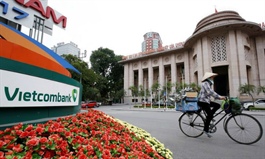Insurance segment sits in good stead
Insurance segment sits in good stead
Despite several challenges stemming from intense competition, the health crisis, and low interest rates, the local insurance landscape is predicted to maintain its growth momentum in 2021.

Experts predict healthy figures for life and non-life insurance segments this year, photo Le Toan
|
Military Insurance Corporation last week officially re-listed 130 million shares on the Ho Chi Minh City Stock Exchange, switching from the Unlisted Public Company Market, with a reference price of around VND15,500 (67 US cents).
Other insurers are also going public or working with foreigners. For instance, Petrolimex Insurance JSC – a subsidiary of Petrolimex – has confirmed to raise its foreign cap from 49 per cent to 100 per cent.
Currently Vietnam boasts 31 non-life insurers, 18 life insurers, 16 brokers, and two reinsurers. Many reputable foreign insurance companies have a presence in Vietnam in both life and non-life sectors.
However, according to brokerage Saigon Securities Incorporation (SSI), aviation, travel, and freight insurances, which make up for around 6 per cent of the total non-life insurance premium revenue, were heavily affected by the COVID-19 pandemic.
The premium revenue for both health and life insurance reported a plunge in the social distancing period in March and April of 2020. However, these segments witnessed a steady recovery in the following months.
According to the Association of Vietnam Insurance, the health and life insurance premium revenue in the first three quarters of 2020 increased by 25.6 and 21.2 per cent, respectively, against the same period of 2019.
SSI indicated that the two largest enterprises are losing market share in life and non-life insurance, demonstrating fierce industry competition.
In the first three quarters of last year, the non-life market share of Bao Viet Holdings Group and PetroVietnam Insurance decreased while six companies increased their life insurance market share – Manulife, AIA, Generali, MB Ageas, FWD, and Aviva. Others lost market shares, such as BaoViet Life, Prudential, Dai-ichi Life, Chubb Life, and Hanwha Life.
In late December, VietinBank and Canadian insurer Manulife inked an exclusive 16-year bancassurance partnership to better meet the growing financial and insurance needs of Vietnamese people.
Manulife would also acquire insurance firm Aviva Vietnam since the latter formed a joint venture with VietinBank to distribute insurance products. Manulife’s life insurance market share is predicted to reach 18.5 per cent – nearly equal to Prudential’s share of 18.8 per cent.
“We’re in an exclusive bancassurance agreement with Techcombank, SCB, and VietinBank, three prestigious groups, and are putting in our best efforts to become the market leader in this regard,” said Hoe Shin Koh, chief partnership distribution officer at Manulife Vietnam. “Bancassurance is our strategic approach not just in Vietnam, but in the entire Asian market. For instance, in 2015, Manulife Asia paid $1.2 billion to Singapore’s DBS Group Holdings for a 15-year partnership, allowing us to sell products through this lender’s Asian branch network.”
Experts at SSI forecasted that the growth of the premium revenue for life and non-life insurance segments in 2021 would be 22 and 10-12 per cent on-year, respectively.
“However, the insurance industry will still face numerous roadblocks, including low-interest rates and increasing re-insurance costs. These factors will consequently reduce insurers’ profit because their investment portfolios are bank deposits and government bonds. Also, if the government bond yields drop, profits will be negatively impeded due to higher life-insurance reserves,” said SSI.
In 2020, in spite of the pandemic, the insurance market still maintained growth momentum with total property insurance of approximately VND552.4 trillion ($24.01 billion), up 21.5 per cent on-year, according to the statistics published by the Ministry of Finance (MoF).
Total equity capital was estimated at VND113.5 trillion ($4.9 billion) and total insurance premium was VND184.7 trillion ($8.03 billion), signifying increases by 27 and 15.2 per cent respectively. The claim cost was VND48.2 trillion ($2.09 trillion).
Data revealed by the MoF also showed that between 2016 and 2020, the total assets of the insurance market witnessed an average hike by 19 per cent on-year, with the figure for 2020 estimated at VND526 trillion ($22.87 billion).
The total money that insurance companies invested back to the economy saw an average increase by 19.4 per cent, with an estimated VND416 trillion ($18.09 billion) in 2020. The whole premium income boosts an average of 19.3 per cent and was estimated at VND226 trillion ($9.83 billion) last year.
The MoF continued to improve the draft decree on compulsory civil liability insurance for motor vehicle owners, replacing Decree No.103/2008/ND-CP dated 2008 and Decree No.214/2013/ND-CP from 2013. In addition, vehicle insurance is forecast to grow strongly, especially after Decree No.70/2020/ND-CP from last year introduced a registration fee cut of 50 per cent for cars.
KIS Securities believed the local government’s eagerness to accelerate development of the domestic car market will lay a vital foundation for vehicle insurance in particular.
























